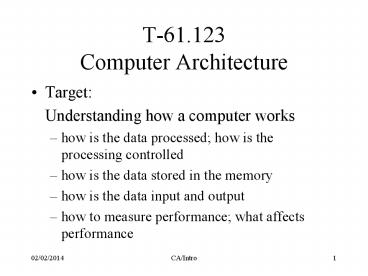T-61.123 Computer Architecture - PowerPoint PPT Presentation
Title:
T-61.123 Computer Architecture
Description:
http://www.mkp.com/cod2e.htm. Web extensions of the book's content. Three sets of lecture s ... vacuum tube transistor IC VLSI ... – PowerPoint PPT presentation
Number of Views:36
Avg rating:3.0/5.0
Title: T-61.123 Computer Architecture
1
T-61.123 Computer Architecture
- Target
- Understanding how a computer works
- how is the data processed how is the processing
controlled - how is the data stored in the memory
- how is the data input and output
- how to measure performance what affects
performance
2
Course Administration
- Instructor Dr. Seppo Haltsonen
(seppo.haltsonen_at_evtek.fi) - Assistants NN (tark_at_hut.fi)
- Project SPIM simulator...
- Registration wwwTopi!
- Materials Delivered via Otapaino
- Newsgroup opinnot.tik.tark
3
Course Administration
- 11 lectures on Thursdays at 16.15
- 6 tutorial sessions, extra points available
- Course assistants
- give all kind of help
- reception time and place announced later
- can be best contacted by e-mail
4
Assessment
- exam grade 2/3 project grade
1/3 - course grade
- Exam contains 5 problems, max 6 points each to
pass one has to get at least 12 points - If the project is late, its grade is reduced
5
Project
- Deals with MIPS instruction set architecture
- The project is personal
- Deadline is 1st December
- The report has to be returned by e-mail
6
Expected Previous Knowledge
- Basic knowledge of computers
- Basic knowledge of programming
- instructions, program structures
- Fundamentals of computer technology
- gates, flip-flops, combinational circuits,
registers, sequential circuits
7
Textbook
- David A. Patterson and John L. Hennessy, Computer
Organization Design The Hardware/Software
Interface, 2nd Edition, Morgan Kaufmann, 1998 - Need 2nd Edition? Yes!
- gtgt 50 text changed, all exercises changed, all
examples modernised, new sections, ...
8
Support Materials
- http//www.mkp.com/cod2e.htm
- Web extensions of the books content
- Three sets of lecture slides
- SPIM simulator
- Lecture slides are mostly based on the above
slide sets (especially those of Tod Amon)
9
What computers are
- Computers are programmable electronic devices.
- They solve problems using algorithms.
- They consist of hierarchical layers of hardware
and software.
10
An algorithm
- Compute the average age of a group of people.
- 1. n number of people input
- 2. sum 0
- 3. i n
- 4. sum sum age of person i input
- 5. i i-1
- 6. if i gt 0 then go to 4
- 7. sum sum/n
- 8. average age sum output
11
What is involved in an algorithm?
- data (operands and results)
- operations
- control (order of operations)
12
Hardware layers
- structures on silicon or other materials
- electronic components (transistors etc.)
- logic components (gates, flip-flops)
- logic circuits (adders, registers, counters,
etc.) - functional units (ALU, multiplier, shifter,
register file, control unit) - computer components (CPU, memory, I/O unit)
- computer system
13
Software layers
- Machine language
- 0010 1011 1101 1000
- 1001 0111 0101 1110
- Assembly language
- MOV A, 3CH
- ADD A, 20H
- High-level language
- y 15
- x (yy-5, 30/y)
14
Abstractions
- hardware or software layers are called
abstractions - abstractions are a way to cope with complexity
- lower-level details are hidden to offer a simpler
model at higher levels
15
Definition one
- Computer architecture
- attributes of a system visible to a programmer
instruction set, data types, I/O mechanisms,
addressing of memory - Computer organisation
- hardware details transparent to a programmer
operational units and their interconnections,
peripheral interfaces, memory technology
16
An example
- architectural issue has the computer a multiply
instruction or not? - organisational issue has the computer a special
multiply unit or does it repeatedly use the add
unit?
17
Definition two
- Computer architecture
- Instruction set architecture
- Machine organisation
- Instruction set architecture interface between
the hardware and low-level software
18
Instruction set architecture
- Organisation of storage registers, memory
- Representations of data
- Instruction set
- Instruction formats
- Modes of addressing and accessing data
- Exceptional conditions
19
Instruction set architecture
- Advantage enables different implementations of
the same architecture - Disadvantage may prevent using new innovations
20
Machine organisation
- Implementation, capabilities and performance
characteristics of functional units - Interconnections of these units
- Information flows between these units
- Control of information flow
- VHSIC Hardware Description Language (VHDL)
descriptions
21
Block diagram of a computer
CPU
ALU
Input Unit
Output Unit
Control Unit
Register Unit
Memory
22
Computer blocks
- ALU calculations
- Register unit data, memory addresses
- Control unit control of the whole computer
- Memory data, programs
- I/O unit communication with the surroundings
23
Instruction cycle
- Fetch instruction
- Decode instruction
- Fetch operands
- Execute operation
- Store result
- Locate next instruction
24
Instruction fetch
25
Technology changes
- vacuum tube ? transistor ? IC ? VLSI
- Moores law number of transistors on a single
chip doubles every 1.5 years - Consequences of Moores law (and other
improvements) - processor performance and memory capacity double
every 1.5 years - computers get smaller, faster and cheaper
26
Contents of the course
- Performance issues
- MIPS instruction set architecture
- Datapath (ALU)
- Control
- Memory hierarchy
- I/O interface































